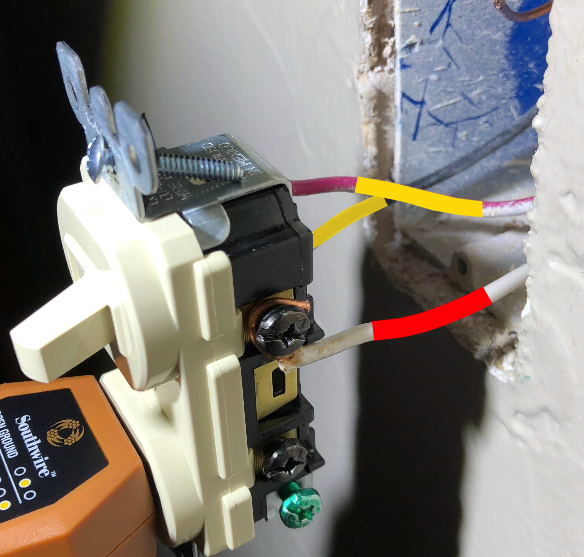This is the "switch-loop" end of a 3-way switch loop circuit. You cannot fit a receptacle because they need hot and neutral, which are not present here.
Wire colorsUse a smart switch
I recently hadThis circuit can be rewired using smart switches to provide hot and neutral here.
In that case, white and black would be re-assigned to be hot and neutral. The red wire would become a 1000sf office with only 3 circuits in conduitcommunication wire, including switched hots for lighting on allif your smart switch type requires it. Typically "smart" 3 circuits-ways are made as a master and remote; the remote would be here. With 9 different conductors, I
That would have lost my mind if it wan't forprovide the color coding by functionhot and neutral which the receptacle also requires.
Wire colors
The only reason people use red black white forIt's really hard to understand 3-ways isway circuits because all wires are black, white and red. They seem to do all different things. Those colors are only used because that's how the cable is manufactured. Now your local hardware sells colored You can make things a lot clearer by marking electrical tape in 5-packs: red blue white green yellowwires by function. And I recommend A 5-pack of electrical tape makes this easy. Mind you use tape to color-code every, if neutral is present, it must be on the white wire. Otherwise, as follows:tape away, but mark each wire the same on both ends. I like
- Always-hot -- black.
- Neutral - for always- native white or gray.hot, as to a receptacle
- Switchedred for switched-hot (toto a lamp) -- Red.
- 3/4 way messengersyellow for -- Yellowboth travelers. (There is noThere isn't really any need to distinguish messengers from each other).
- Second circuits White - Neutral.
- Grounds - native bare, green or green/yellow, which can only be groundstell them apart.
Note that you cannot remark wires to be grounds or neutrals. But you can remark a white wire to be anything but a ground.
Your situation
Your receptacle will want always-hot and neutral -- if you have marked wires as I say, those will be (marked) black and white. But what do you have? We can tell.
Your black screw on the switch is common. That means the other two are definitely messengers - mark them yellow on both ends. (The other end is at the other 3-way). While you're in the other box, figure out if the white is always-hot or switched-hot to the lamp, and mark it also.
So now you see your wires are yellow-yellow-black or yellow-yellow-red. No neutral in this box, and possibly, no always-hot. So a receptacle is impossible, unless we bring over another cable.
The neutral-with-hot rule says that if we bring over another cable, the neutral in that cable must go with the hot in that cable, so both would go to the receptacle. This is to keep currents equal in each cable, important to prevent EMF damage such as eddy current heating.
Smart switches save the day
Generally, with "smart switches", including 3/4 way, you wire always-hot and neutral to each location, because the smart switches need it. Whaddaya knowNow your switch, that'sand the opposite switch as well, look like this. Now it's clear what those wires are doing, none are hot or neutral, and that's why your receptacle needs too!can't work. That was easy!
What about the red wire? Typically, in an installation like this, this location would be not the master, but the "remote". In some systems like Insteon, the remote switch communicates with the "master" via radio or powerline signaling, and the red wire would be useless and should be capped off (never cut). Other types of smart switch need a hardwired "communication wire", in which case you would use the red wire for that.
WWTD?
If the year was 1917, And you were Nikola TeslaLastly, you could still employ the "smart switch" solution. You would wire it as per the smart switch. And then havethere's a plain old single switch either connect the red wire to "always-hot", or not. Back at the other 3-way, red would goway to a new-fangled "relay" and operate itdo this with "old fashioned relays". The relay would be SPDT, just like a 3-way switch, and you It's what Tesla would wire the relay as if it were the other 3-way. You can still do this solution todayin 1910, but there'd be no reason to, given the existence of smart switches are easier so I'm excluding the details. If you want them, ask.

